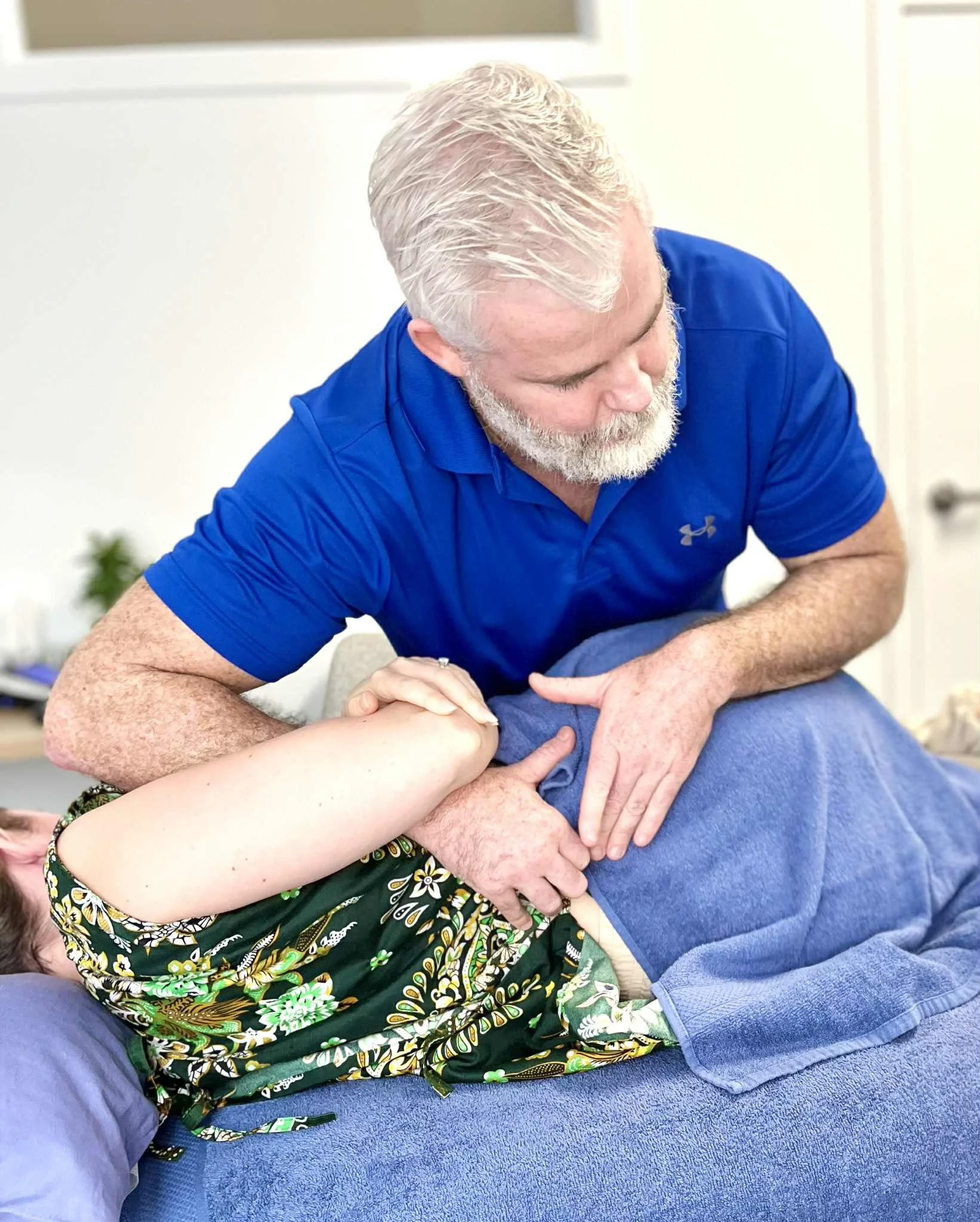Crack the Code: What Really Happens During Spinal Manipulation?
Few sounds spark such intrigue in healthcare as the sharp crack that accompanies a spinal adjustment. To some, it signals relief and alignment. To others, it raises red flags about safety and efficacy. But what does the science actually say?
In this blog post, we dive into the biomechanics, neurology, evidence base, and ongoing controversies surrounding spinal manipulation. Drawing on over 40 peer-reviewed studies, this is your comprehensive guide to understanding what spinal manipulation really does — and what it doesn’t.
What Causes the "Crack" in Spinal Manipulation?
The audible release during spinal manipulation is often believed to be due to cavitation — the rapid formation and collapse of gas bubbles within the synovial fluid of a joint. There are several studies that have explored this over the years and currently the most likely explanation is the formation of a gaseous space in the joint.
"The cracking sound appears to result from the formation of a gas bubble, not its collapse, as previously thought" (Herzog, 2010).
The biomechanics of the technique involve a high-velocity, low-amplitude (HVLA) thrust, designed to create gapping in the facet joints (or other joints of the body). This gapping stretches the joint capsule and leads to the release of gas within the joint fluid.
Spinal Manipulation and the Nervous System
The effects of spinal manipulation extend beyond the musculoskeletal system. Studies have shown significant changes in neural processing and sensorimotor integration.
"Spinal manipulation may alter afferent input to the central nervous system, affecting motor output and pain perception" (Haavik & Murphy, 2012).
Neurophysiological responses include:
Modulation of spinal cord excitability
Altered activity in sensorimotor brain regions
Reduced temporal summation of pain
These effects may explain the pain-relieving and mobility-improving outcomes reported by patients.
Hormonal and Immune System Responses
Fascinatingly, some studies suggest that spinal manipulation can influence biochemical markers associated with stress and pain, such as cortisol, oxytocin, and substance P.
"Following spinal manipulation, levels of substance P and cortisol were significantly reduced, correlating with decreased pain perception" (Kranenburg et al., 2020).
Though more research is needed to determine clinical relevance, these findings open a window into how manipulation might interact with the body's stress and immune systems.
What the Evidence Says About Clinical Efficacy
Research on the efficacy of spinal manipulation is mixed — and highly condition-specific.
Supported By Evidence:
Acute and subacute low back pain (Goertz et al., 2018; Rubinstein et al., 2012)
Neck pain and cervicogenic headache (Fernández-de-Las-Peñas et al., 2020)
Modest improvements in migraine symptoms (Rist et al., 2019)
Less Conclusive:
Chronic non-specific low back pain
Preventive care or wellness maintenance
Non-musculoskeletal conditions (Côté et al., 2021)
Understanding the Risks
Most side effects from spinal manipulation are minor and temporary: soreness, stiffness, or a transient increase in symptoms.
"Adverse events were generally mild-to-moderate in intensity and short in duration" (Nielsen et al., 2021).
However, rare but serious complications like vertebral artery dissection (VAD) have raised legitimate concerns, particularly in cervical manipulation. Risk estimates vary widely, from 1 in 20,000 to 1 in several million manipulations.
"The rarity and methodological limitations of available data make precise risk quantification challenging" (Whedon et al., 2015).
Clinicians are advised to conduct thorough screening and obtain informed consent before cervical adjustments.
Where Research Is Heading
Emerging research is focused on:
Neuroimaging to study brain and spinal cord changes
Biomarker analysis for stress, inflammation, and pain
Differentiating patient subgroups who benefit most
Moreover, researchers are calling for better standardization in manual therapy protocols and improved adverse event reporting.
Final Thoughts
Spinal manipulation is neither a miracle cure nor a quack technique — it’s a nuanced, evolving modality with real benefits and clear limitations.
When applied judiciously, backed by evidence, and informed by proper screening, it can be a powerful tool in a multidisciplinary approach to care.
Whether you’re a curious patient, a student of health sciences, or a skeptical clinician, understanding the science behind the crack is key to making informed decisions.
Want to learn more? Listen to our full podcast episode "Crack the Code: The Science and Controversy of Spinal Manipulation" where we break down the findings, quotes, and controversies in an engaging and conversational format.
References:
Ballenberger, N. (2024). Adverse events after cervical spinal manipulation – A systematic review and meta-analysis of randomized clinical trials. Pain Physician Journal, 27(4), 185-201. https://doi.org/10.36076/ppj.2024.7.185
Bini, P., Hohenschurz-Schmidt, D., Masullo, V., Pitt, D., & Draper-Rodi, J. (2022). The effectiveness of manual and exercise therapy on headache intensity and frequency among patients with cervicogenic headache: A systematic review and meta-analysis. Chiropractic & Manual Therapies, 30(1). https://doi.org/10.1186/s12998-022-00459-9
Colombi, A., & Testa, M. (2019). The effects induced by spinal manipulative therapy on the immune and endocrine systems. Medicina, 55(8), 448. https://doi.org/10.3390/medicina55080448
Conway, P., Herzog, W., Zhang, Y., Hasler, E., & Ladly, K. (1993). Forces required to cause cavitation during spinal manipulation of the thoracic spine. Clinical Biomechanics, 8(4), 210-214. https://doi.org/10.1016/0268-0033(93)90016-b
Currie, S. J., Myers, C. A., Durso, C., Enebo, B. A., & Davidson, B. S. (2016). The neuromuscular response to spinal manipulation in the presence of pain. Journal of Manipulative and Physiological Therapeutics, 39(4), 288-293. https://doi.org/10.1016/j.jmpt.2016.02.011
Côté, P., Hartvigsen, J., Axén, I., Leboeuf-Yde, C., Corso, M., Shearer, H., Wong, J., Marchand, A., Cassidy, J. D., French, S., Kawchuk, G. N., Mior, S., Poulsen, E., Srbely, J., Ammendolia, C., Blanchette, M., Busse, J. W., Bussières, A., Cancelliere, C., … Yu, H. (2021). The global summit on the efficacy and effectiveness of spinal manipulative therapy for the prevention and treatment of non-musculoskeletal disorders: A systematic review of the literature. Chiropractic & Manual Therapies, 29(1). https://doi.org/10.1186/s12998-021-00362-9
Danazumi, M. S., Nuhu, J. M., Ibrahim, S. U., Falke, M. A., Rufai, S. A., Abdu, U. G., Adamu, I. A., Usman, M. H., Daniel Frederic, A., & Yakasai, A. M. (2023). Effects of spinal manipulation or mobilization as an adjunct to neurodynamic mobilization for lumbar disc herniation with radiculopathy: A randomized clinical trial. Journal of Manual & Manipulative Therapy, 31(6), 408-420. https://doi.org/10.1080/10669817.2023.2192975
Fernandez, M., Moore, C., Tan, J., Lian, D., Nguyen, J., Bacon, A., Christie, B., Shen, I., Waldie, T., Simonet, D., & Bussières, A. (2020). Spinal manipulation for the management of cervicogenic headache: A systematic review and meta‐analysis. European Journal of Pain, 24(9), 1687-1702. https://doi.org/10.1002/ejp.1632
Gou, Y., Meng, L., Chen, S., Jiang, Z., & Lei, H. (2025). Analysis of kinematic and kinetic changes in scoliosis following spinal manipulation. Scientific Reports, 15(1). https://doi.org/10.1038/s41598-025-87812-z
Gyer, G., Michael, J., Inklebarger, J., & Tedla, J. S. (2019). Spinal manipulation therapy: Is it all about the brain? A current review of the neurophysiological effects of manipulation. Journal of Integrative Medicine, 17(5), 328-337. https://doi.org/10.1016/j.joim.2019.05.004
Gyer, G., Michael, J., Inklebarger, J., & Ibne Alam, I. (2022). Effects of biomechanical parameters of spinal manipulation: A critical literature review. Journal of Integrative Medicine, 20(1), 4-12. https://doi.org/10.1016/j.joim.2021.10.002
Jun, P., Pagé, I., Vette, A., & Kawchuk, G. (2020). Potential mechanisms for lumbar spinal stiffness change following spinal manipulative therapy: A scoping review. Chiropractic & Manual Therapies, 28(1). https://doi.org/10.1186/s12998-020-00304-x
Kovanur Sampath, K., Mani, R., Cotter, J. D., & Tumilty, S. (2015). Measureable changes in the neuro-endocrinal mechanism following spinal manipulation. Medical Hypotheses, 85(6), 819-824. https://doi.org/10.1016/j.mehy.2015.10.003
Kovanur-Sampath, K., Mani, R., Cotter, J., Gisselman, A. S., & Tumilty, S. (2017). Changes in biochemical markers following spinal manipulation-a systematic review and meta-analysis. Musculoskeletal Science and Practice, 29, 120-131. https://doi.org/10.1016/j.msksp.2017.04.004
Kranenburg, H., Schmitt, M., Puentedura, E., Luijckx, G., & van der Schans, C. (2017). Adverse events associated with the use of cervical spine manipulation or mobilization and patient characteristics: A systematic review. Musculoskeletal Science and Practice, 28, 32-38. https://doi.org/10.1016/j.msksp.2017.01.008
Kuik, M., Calley, D., Buus, R., & Hollman, J. (2023). Beliefs and practice patterns of spinal thrust manipulation for mechanical low back pain of physical therapists in the state of Minnesota. Journal of Manual & Manipulative Therapy, 32(4), 421-428. https://doi.org/10.1080/10669817.2023.2279821
Masaracchio, M., Kirker, K., States, R., Hanney, W. J., Liu, X., & Kolber, M. (2019). Thoracic spine manipulation for the management of mechanical neck pain: A systematic review and meta-analysis. PLOS ONE, 14(2), e0211877. https://doi.org/10.1371/journal.pone.0211877
Minnucci, S., Innocenti, T., Salvioli, S., Giagio, S., Yousif, M. S., Riganelli, F., Carletti, C., Feller, D., Brindisino, F., Faletra, A., Chiarotto, A., & Mourad, F. (2023). Benefits and harms of spinal manipulative therapy for treating recent and persistent Nonspecific neck pain: A systematic review with meta-analysis. Journal of Orthopaedic & Sports Physical Therapy, 53(9), 510-528. https://doi.org/10.2519/jospt.2023.11708
Molina-Ortega, F., Lomas-Vega, R., Hita-Contreras, F., Plaza Manzano, G., Achalandabaso, A., Ramos-Morcillo, A. J., & Martínez-Amat, A. (2014). Immediate effects of spinal manipulation on nitric oxide, substance P and pain perception. Manual Therapy, 19(5), 411-417. https://doi.org/10.1016/j.math.2014.02.007
Nielsen, S. M., Tarp, S., Christensen, R., Bliddal, H., Klokker, L., & Henriksen, M. (2017). The risk associated with spinal manipulation: An overview of reviews. Systematic Reviews, 6(1). https://doi.org/10.1186/s13643-017-0458-y
Nim, C. G., Weber, K. A., Kawchuk, G. N., & O’Neill, S. (2021). Spinal manipulation and modulation of pain sensitivity in persistent low back pain: A secondary cluster analysis of a randomized trial. Chiropractic & Manual Therapies, 29(1). https://doi.org/10.1186/s12998-021-00367-4
Pasquier, M., Chéron, C., Barbier, G., Dugas, C., Lardon, A., & Descarreaux, M. (2020). Learning spinal manipulation: Objective and subjective assessment of performance. Journal of Manipulative and Physiological Therapeutics, 43(3), 189-196. https://doi.org/10.1016/j.jmpt.2019.12.010
Plaza-Manzano, G., Molina-Ortega, F., Lomas-Vega, R., Martínez-Amat, A., Achalandabaso, A., & Hita-Contreras, F. (2014). Changes in biochemical markers of pain perception and stress response after spinal manipulation. Journal of Orthopaedic & Sports Physical Therapy, 44(4), 231-239. https://doi.org/10.2519/jospt.2014.4996
Posadzki, P., Klimek, A. T., & Ernst, E. (2024). Spinal manipulations for migraine: An updated systematic review and meta-analysis of randomized clinical trials. Systematic Reviews, 13(1). https://doi.org/10.1186/s13643-024-02719-6
Rist, P. M., Hernandez, A., Bernstein, C., Kowalski, M., Osypiuk, K., Vining, R., Long, C. R., Goertz, C., Song, R., & Wayne, P. M. (2019). The impact of spinal manipulation on migraine pain and disability: A systematic review and meta‐analysis. Headache: The Journal of Head and Face Pain, 59(4), 532-542. https://doi.org/10.1111/head.13501
Rubinstein, S. M., De Zoete, A., Van Middelkoop, M., Assendelft, W. J., De Boer, M. R., & van Tulder, M. W. (2019). Benefits and harms of spinal manipulative therapy for the treatment of chronic low back pain: Systematic review and meta-analysis of randomised controlled trials. BMJ, l689. https://doi.org/10.1136/bmj.l689
Rubinstein, S. M., Terwee, C. B., Assendelft, W. J., De Boer, M. R., & Van Tulder, M. W. (2013). Spinal manipulative therapy for acute low back pain. Spine, 38(3), E158-E177. https://doi.org/10.1097/brs.0b013e31827dd89d
Schneider, M., Haas, M., Glick, R., Stevans, J., & Landsittel, D. (2015). Comparison of spinal manipulation methods and usual medical care for acute and subacute low back pain. Spine, 40(4), 209-217. https://doi.org/10.1097/brs.0000000000000724
Stickler, K., & Kearns, G. (2022). Spinal manipulation and adverse event reporting in the pregnant patient limits estimation of relative risk: A narrative review. Journal of Manual & Manipulative Therapy, 31(3), 162-173. https://doi.org/10.1080/10669817.2022.2118653
Trager, R. J., Baumann, A. N., Perez, J. A., Dusek, J. A., Perfecto, R. T., & Goertz, C. M. (2024). Association between chiropractic spinal manipulation and cauda equina syndrome in adults with low back pain: Retrospective cohort study of US academic health centers. PLOS ONE, 19(3), e0299159. https://doi.org/10.1371/journal.pone.0299159
Whedon, J. M., Petersen, C. L., Schoellkopf, W. J., Haldeman, S., MacKenzie, T. A., & Lurie, J. D. (2023). The association between cervical artery dissection and spinal manipulation among US adults. European Spine Journal, 32(10), 3497-3504. https://doi.org/10.1007/s00586-023-07844-9





